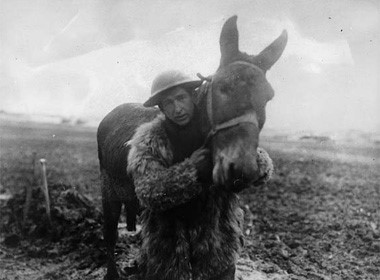November 11, 2019
Lest We Forget

A few years ago I wrote the following blog, which I believe still warrants sharing this Remembrance Day.
As we prepare to honour the men and women that fought, and to remember those that gave their lives combat, we hope you will also take a moment to remember the vast numbers of animals that were killed in wartime—often suffering agonizing deaths from wounds, starvation, thirst, exhaustion, disease and exposure.
Ottawa and all of Canada are proud to have a memorial to those millions of animals that died in wartime, thanks to the efforts of 90-year-old veteran Lloyd Swick. The memorial, installed in Confederation Park last November, is a tribute to all the animals that died in service of soldiers in wartime.
In this time of high-tech warfare, it is hard to imagine the reliance on animals that was a hallmark of wars until late in the 20th century. The use of animals in wartime is well-summarized on the U.K’s Animals in War Memorial website:
Horses, Mules and Donkeys
Eight million horses and countless mules and donkeys died in the First World War. They were used to transport ammunition and supplies to the front and many died, not only from the horrors of shellfire but also in terrible weather and appalling conditions. Mules were found to have tremendous stamina in extreme climates and over the most difficult terrain, serving courageously in the freezing mud on the Western Front and later at Monte Cassino in World War II. Equally they toiled unflinchingly in the oppressive heat of Burma, Eritrea and Tunisia. There are many inspiring and often tragic stories of the great devotion and loyalty shown between horses, mules and donkeys and their masters during some of the bloodiest conflicts of the 20th century.
Dogs
The dog’s innate qualities of intelligence and devotion were valued and used by the forces in conflicts throughout the century. Among their many duties, these faithful animals ran messages, laid telegraph wires, detected mines, dug out bomb victims and acted as guard or patrol dogs. Many battled on despite horrific wounds and in terrifying circumstances to the limit of their endurance, showing indomitable courage and supreme loyalty to their handlers.
Pigeons
More than 100,000 pigeons served Britain in the First World War and 200,000 in World War II. They performed heroically and saved thousands of lives by carrying vital messages, sometimes over long distances, when other methods of communication were impossible. Flying at the rate of a mile a minute from the front line, from behind enemy lines or from ships or airplanes, these gallant birds would struggle on through all weathers, even when severely wounded and exhausted, in order to carry their vital messages home.
Other Animals
Elephants, camels, oxen, bullocks, cats, canaries, even glow worms — all these creatures, great and small, contributed their strength, their energy and their lives in times of war and conflict to the British, Commonwealth and Allied forces during the 20th century.
So, once the moment of silence ends after the eleventh minute of the eleventh hour, of the eleventh day, of the eleventh month, please join with us to remember our animal friends that died alongside our soldiers.
Bruce Roney
President and CEO
